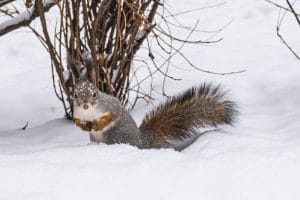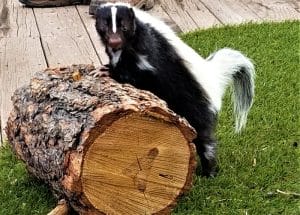When providing humane wildlife removal and relocation services, the Bad Company team has to be ready to handle a lot of different cases. However, a few critters are bigger troublemakers than others! Here are the five most common animals we’re called to remove from Hamilton homes and properties – and what you can do to keep them away.
Raccoons (Procyon lotor)

Raccoons are nocturnal, hunting and scavenging for food at night and sleeping throughout the day – unless they are hungry, sick, or woken up. Like most humans, they are omnivorous, meaning our leftovers are their ideal dinner; even when we humans think we’ve cracked the secret to a raccoon-proof garbage can.
In feeling more comfortable around us, raccoons pose a danger to people and pets. Do not try to remove raccoons yourself; a strain of rabies is circulating in the city’s raccoon population.
Coyotes (Canis latrans)

If you encounter one alone outdoors, don’t run – rather, stretch out your arms and legs to make yourself look as large as possible. Start making loud noises, blow a whistle, or noisily open and close an umbrella.
Because Hamiltonians are outside less due to COVID-19, there have only been 21 coyote sightings in 2020 so far (compared to 310 in 2019). But if you do see one around your home, stay indoors and don’t leave small children, cats, or dogs outside alone when there are reports of a coyote in your area.
Skunks (Mephitis mephitis)

One reason skunks are so common in urban environments is that they love eating grubs in lawns. This causes a lot of damage to grass and gardens, and the skunks may make a home inside sheds or under porches and patios. You can use natural remedies from garden stores to keep skunks from digging up your lawn for grubs, such as nematodes. You can also lay down an inch of mesh or chicken wire to keep skunks from digging up your lawn.
If you want a skunk removed, call a professional and do not get close; the same strain of rabies affecting the city’s raccoon population also infects skunks.
Squirrels

What makes them a unique pest on this list is that Eastern Grey squirrels mate twice a year: from December to February and from June to August. They often take up space in Hamilton homes wherever there’s an opening, from the cavities and overhangs above your porch to your attic.
Squirrels are unpredictable, and won’t hesitate to scratch and bite when they feel threatened. They are also capable of spreading disease and parasites. Since these tiny animals are highly evasive, don’t try to handle them yourself; call a professional wildlife removal company who understands how they move!
Bats

To keep bats out, check places where they may get into your home: chimneys, corners, joints, pipes entering ceilings or walls in attics, and between shingles or where walls meet eaves. If you notice even the tiniest crack, seal it – either it could grow to become a suitable entry hole, or it already is one.
Before you seal up the cracks, make sure no bats are roosting in your attic already. Don’t seal up openings in late summer or early fall because you could trap bat babies inside. Rather, have a humane wildlife removal company come and survey your attic or chimney first!
How Can I Keep Local Wildlife Away From My House?
Other than the specific recommendations for each common critter, what else can you do to keep these five animals away? For starters, do not leave food out for wild animals other than birds. Even if you think leaving a little lettuce out for some bunnies is fine, you’ll attract other unwanted attention. Choose bird feeders that are squirrel-proof, and keep pet food inside your house, too.
If you do place your garbage and compost outside, put them in hard plastic containers with locking lids. Try to pick and remove any extra fruit or vegetables from your trees and gardens. You can also add motion-sensitive lights to your yard, as nocturnal wildlife are less likely to travel in well-lit areas.



